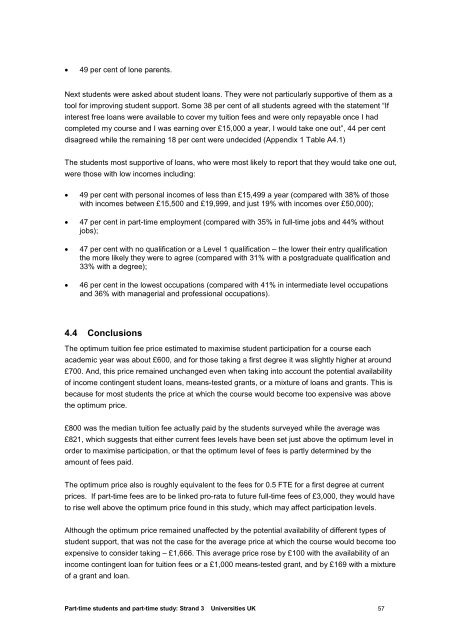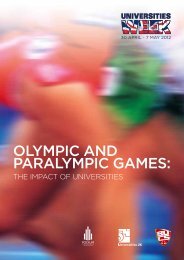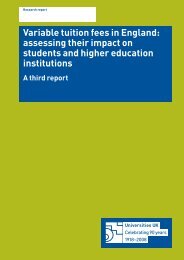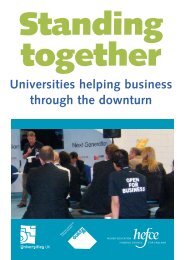Part-time Students And part-time Study In Higher ... - Universities UK
Part-time Students And part-time Study In Higher ... - Universities UK
Part-time Students And part-time Study In Higher ... - Universities UK
Create successful ePaper yourself
Turn your PDF publications into a flip-book with our unique Google optimized e-Paper software.
• 49 per cent of lone parents.Next students were asked about student loans. They were not <strong>part</strong>icularly supportive of them as atool for improving student support. Some 38 per cent of all students agreed with the statement “Ifinterest free loans were available to cover my tuition fees and were only repayable once I hadcompleted my course and I was earning over £15,000 a year, I would take one out”, 44 per centdisagreed while the remaining 18 per cent were undecided (Appendix 1 Table A4.1)The students most supportive of loans, who were most likely to report that they would take one out,were those with low incomes including:• 49 per cent with personal incomes of less than £15,499 a year (compared with 38% of thosewith incomes between £15,500 and £19,999, and just 19% with incomes over £50,000);• 47 per cent in <strong>part</strong>-<strong>time</strong> employment (compared with 35% in full-<strong>time</strong> jobs and 44% withoutjobs);• 47 per cent with no qualification or a Level 1 qualification – the lower their entry qualificationthe more likely they were to agree (compared with 31% with a postgraduate qualification and33% with a degree);• 46 per cent in the lowest occupations (compared with 41% in intermediate level occupationsand 36% with managerial and professional occupations).4.4 ConclusionsThe optimum tuition fee price estimated to maximise student <strong>part</strong>icipation for a course eachacademic year was about £600, and for those taking a first degree it was slightly higher at around£700. <strong>And</strong>, this price remained unchanged even when taking into account the potential availabilityof income contingent student loans, means-tested grants, or a mixture of loans and grants. This isbecause for most students the price at which the course would become too expensive was abovethe optimum price.£800 was the median tuition fee actually paid by the students surveyed while the average was£821, which suggests that either current fees levels have been set just above the optimum level inorder to maximise <strong>part</strong>icipation, or that the optimum level of fees is <strong>part</strong>ly determined by theamount of fees paid.The optimum price also is roughly equivalent to the fees for 0.5 FTE for a first degree at currentprices. If <strong>part</strong>-<strong>time</strong> fees are to be linked pro-rata to future full-<strong>time</strong> fees of £3,000, they would haveto rise well above the optimum price found in this study, which may affect <strong>part</strong>icipation levels.Although the optimum price remained unaffected by the potential availability of different types ofstudent support, that was not the case for the average price at which the course would become tooexpensive to consider taking – £1,666. This average price rose by £100 with the availability of anincome contingent loan for tuition fees or a £1,000 means-tested grant, and by £169 with a mixtureof a grant and loan.<strong>Part</strong>-<strong>time</strong> students and <strong>part</strong>-<strong>time</strong> study: Strand 3 <strong>Universities</strong> <strong>UK</strong> 57
















